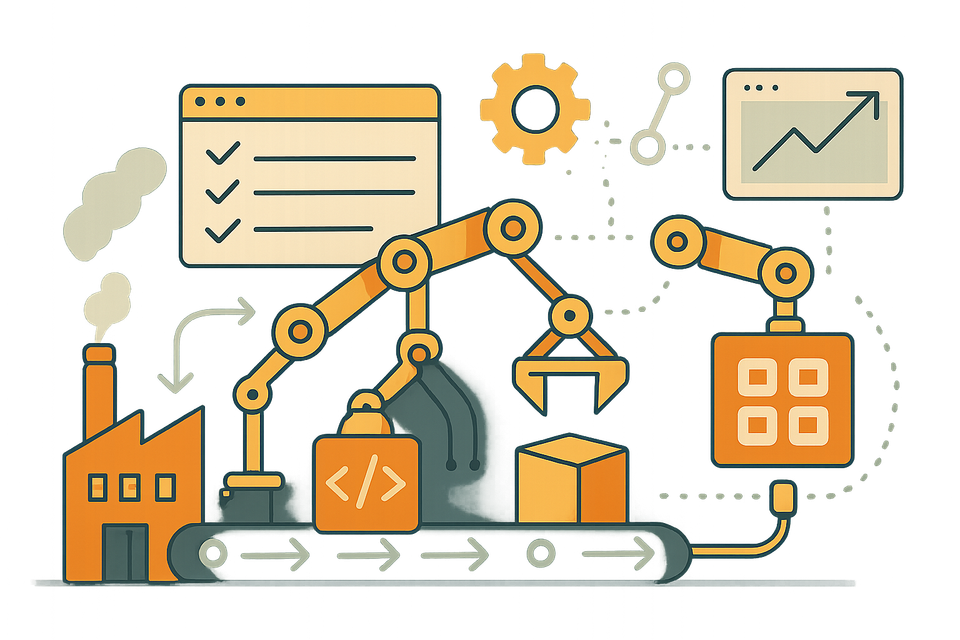Platform 2.0: Building the Software Factory, Not Just the Tools

For over a decade, platform engineering has been the quiet backbone of modern software organisations, standardising infrastructure, accelerating deployments, and reducing toil through reusable tooling. CI/CD pipelines, observability primitives, and infrastructure abstractions helped teams scale without duplicating effort. This was Platform 1.0: the foundational layer of internal enablement.
But today, those foundations are not enough.
Software complexity has shifted upwards. It is no longer just a question of how services are deployed or how fast we release. The real bottlenecks now lie in the product delivery chain itself, in the fractured handoffs, misaligned cadences, and lack of leverage across teams. Many organisations are still trying to operate modern product delivery like an assembly line with hand tools.
We need factories.
From Platform 1.0 to Platform 2.0
Platform 1.0 focused on tooling, infrastructure, and developer efficiency. Platform 2.0 goes further: it focuses on delivery systems. It treats the platform not as a toolbox, but as a software factory: a programmable environment where delivery logic is encoded into reusable, safe, and observable machines.
Let us contrast the shift:
| Dimension | Platform 1.0 | Platform 2.0 |
|---|---|---|
| Focus | Infrastructure and DevOps | Product-aware delivery systems |
| Output | Tools and templates | Reusable machines, SDKs, workflows |
| Value | Efficiency and scale | Leverage and acceleration |
| Mental Model | Services and tooling | Systems and factories |
In this new model, the role of the platform is not to dictate how features are built, but to provide the programmable machinery that lets teams shape their own delivery pipelines safely and consistently.
Enablement Through Platform Primitives
Enablement in Platform 2.0 does not mean handing over tools: it means creating leverageable systems that frame and support high-quality decision-making. This enablement is expressed through carefully designed platform primitives that product teams can adapt without reinventing infrastructure.
In practice, it means extending core platform primitives like deployment, versioning, and canary testing with product-awareness:
- Deployment is no longer just a push to production, it might involve releasing a mobile SDK to a segment of users with rollback and cross-platform tracking.
- Versioning includes not only backend contracts, but long-tail clients, public APIs, and behavioural changes.
- Canary testing must measure business behaviour (conversion, retention), not just latency or error rates.
This is where Product Platform teams operate. They do not simply expose infrastructure. They design interfaces for enablement. Each primitive becomes a reusable contract that encodes best practices, compliance, and observability by design.
For example:
- A deployment system that supports phased rollout by user segment enables experimentation and rollback, not just speed.
- A versioning strategy that handles legacy clients and backward compatibility creates product safety and customer trust.
- A canary framework tied to product metrics (not infrastructure logs) empowers data-driven decisions at the feature level.
These are not tools. These are platform machines for enablement and their shape is defined by the leverage we seek to create.. They do not just offer templates. They build the machines, SDK systems, client release frameworks, feature exposure models that allow product teams to ship with confidence and scale.
The Limits of DORA and the Need for System Metrics
The popular DORA metrics (lead time, deploy frequency, MTTR, change fail rate) have served engineering teams well. But they do not tell us whether a platform is enabling value.
In Platform 2.0, we need to ask:
- How quickly can a product idea reach a measurable audience? (Time to business impact)
- Can multiple teams reuse platform components to reduce duplication? (Leverage rate)
- Do platform systems close the loop with usage data? (Feedback responsiveness)
Platforms should not just ship tools. They should enable system learning.
The Platform 2.0 Manifesto
With this shift comes a new philosophy. The old startup mantra, "build fast, fail fast", was never designed for regulated, scaled, or interdependent environments. It prioritised local speed at the cost of systemic safety.
Here is the mindset shift:
| Instead of... | We embrace... |
|---|---|
| Build fast | Build safely and composably |
| Run fast | Deliver with purpose and traceability |
| Fail fast | Learn deliberately and close the loop |
| Automate everything | Encode intent into programmable systems |
| Move fast and break things | Evolve without collateral damage |
These are not slogans. They are design constraints for platform systems.
Making It Work: The Fluid Organisation
Platform 2.0 introduces a structural challenge. Building the platform machines takes time. Product delivery moves fast. The two must coexist.
The Fluid Organisation model solves this by decoupling cadences while keeping feedback loops tight. It defines clear interfaces between reusable platform systems and evolving product logic. It ensures that:
- Product teams can move at the speed of insight
- Platform teams can invest in systemic leverage
- Both can collaborate without blocking one another
Without this, platforms either become bottlenecks or dissolve into chaos.
A New Model for Platform Leverage
Platform 2.0 is not a tech stack upgrade. It is a different philosophy of work. It is about building factories, machines that encode delivery logic, safety, and reuse. It requires new metrics, shared accountability, and an operating model that respects difference in pace.
If Platform 1.0 helped us scale engineering, Platform 2.0 helps us scale value delivery.
📘 A full white paper expanding on Platform 2.0, complete with detailed system patterns, the Product Platform manifesto, and the Fluid Organisation model, will be released soon.
Follow along or reach out if you would like early access or want to explore how to implement Platform 2.0 in your organisation.
Let us stop shipping tools. Let us start building the factory.





Member discussion